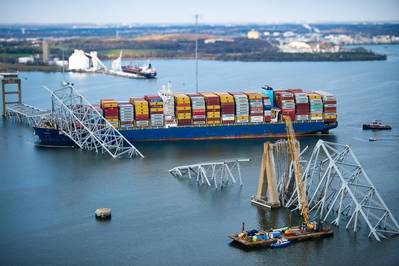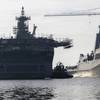Dali Hit Key Bridge with the Force of 66 Heavy Trucks at Highway Speed
The cargo ship Dali knocked down three main truss spans, constructed with connected steel elements forming triangles, on the Francis Scott Key Bridge just seconds after crashing into one of the bridge piers early on Tuesday morning, March 26, 2024.
The bridge collapse happened so fast that it left little time for the work crews on the bridge to escape. Civil engineers like me have been paying attention to this disaster, because we want to find ways to make infrastructure like these large bridges more resilient. For a bridge this large to collapse would require a catastrophic collision force. But using some basic physics principles, we can actually estimate approximately what that force was.
The impulse momentum theorem
You can calculate the magnitude of the Dali’s collision force using a fundamental physics principle called the impulse momentum theorem.
The theorem is derived directly from Newton’s second law, which states that force equals mass times acceleration. The impulse momentum theorem adds time to both sides of this equation, to tell you force multiplied by time equals mass multiplied by the change of velocity when the force is applied.
F*∆t = m*∆v.
To calculate the impulse momentum theory for Dali’s collision, multiply its collision force with how long the collision lasted, and equate that with Dali’s mass multiplied by its change in velocity before and after the crash. So, Dali’s collision force has to do with its mass, how long the collision lasted, and how much it slowed down after the crash.
The numbers for Dali’s crash
Dali weighs 257,612,358 pounds or 116,851 metric tonnes when it is fully loaded. It traveled at a speed of 10 miles per hour, or 16.1 kilometers per hour, before the collision; after crashing into the bridge pier, Dali slowed down to 7.8 miles per hour, or 12.6 kilometers per hour.
Another important parameter is the collision time, which refers to the period of time when the ship contacted the bridge during the crash, which caused Dali to suddenly slow.
Nobody knows the exact collision time yet, but based on Dali’s voyage data recorder and the Maryland Transportation Authority Police log, the total collision time was less than four seconds.
For cars crashing on a highway, the collision time is usually only half a second to one second. Dali’s crash looks similar to how a vehicle might crash on a bridge pier, so it makes sense to use the similar collision time duration to estimate the collision force.
Dali’s collision force
With those estimates and the impulse momentum theory, you can get a pretty good idea of what Dali’s collision force probably was.
Dali’s collision force is calculated by taking Dali’s mass and multiplying it by Dali’s velocity change before and after the crash, then dividing all that by the collision time duration. If you assume the collision time is only one second, that gives a collision force of 26,422,562 pounds.
257,612,358 pounds/(32.2 ft/sec²) * (14.7 feet/sec - 11.4 feet/sec) / 1 sec = 26,422,562 pounds.
For reference, the American Association of State Highway and Transportation Officials specifies that the collision force on a highway bridge pier from a truck crash is about 400,000 pounds.
With that said, the cargo ship Dali’s collision force on the Baltimore Key Bridge pier is equivalent to the scenario of 66 heavy trucks driving with a speed of 60 miles per hour (97 km per hour) and hitting the bridge pier simultaneously. This magnitude is far beyond the force that the pier can withstand.
While designing a super robust bridge that can handle this level of collision force would be technically achievable, doing so would dramatically increase the cost of the bridge. Civil engineers are investigating different approaches that would reduce the force put directly on the piers, such as using energy absorbent protection barriers around the piers that dissipate the shock. These sorts of solutions could prevent disasters like this in the future.
The author
Amanda Bao, Associate Professor of Civil Engineering Technology, Environmental Management and Safety, Rochester Institute of Technology
(Source: The Conversation)














